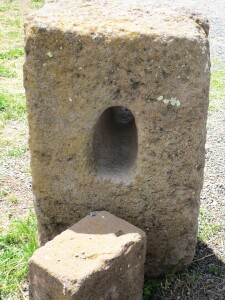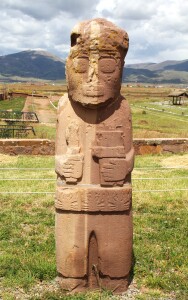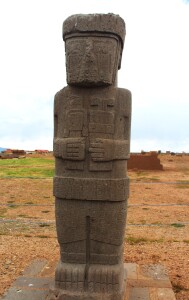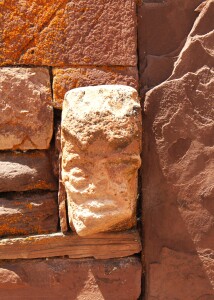Ancient cities of Tiwanaku and Puma Punku
Got to skip ahead to an adventure in Bolivia that, although not related to WW2, it is closely related to another interest, aliens. Just outside La Paz, Bolivia is the ruin complex of Tiwanaku and Puma Punku. Both of these sites date back to around 1500 BCE and have some amazingly similar characteristics to early Egyptian structures.

Our guide said this was a stone megaphone used for calling people to the ceremony. We’ve seen these everywhere in ruins. I think they’re used for wooden poles.
Tiwanaku is first on our list. As I said, it appears that the structures in this complex were created around 1500 BCE based on carbon-dating. As you enter, a three-level step pyramid is off to the right, the Akapana Pyramid. According to archeologists, this pyramid was originally 7 layers tall, with retaining walls at a height of 18 meters (about 60 feet). The pyramid today was reconstructed from materials found at the ruin.

 What’s similar to Egypt? Well, if you’ve been reading this blog, you know that one of the earliest pyramids in the Cairo area was a step-pyramid, the Pyramid of Djoser. This was built around 2700 BCE, so about 1,000 years before Tiwanaku. I guess it’s not too much of a stretch to believe that over the course of 1,000 years, someone from Egypt made their way to South America and shared design information. Maybe. Could have also been a being from another dimension…
What’s similar to Egypt? Well, if you’ve been reading this blog, you know that one of the earliest pyramids in the Cairo area was a step-pyramid, the Pyramid of Djoser. This was built around 2700 BCE, so about 1,000 years before Tiwanaku. I guess it’s not too much of a stretch to believe that over the course of 1,000 years, someone from Egypt made their way to South America and shared design information. Maybe. Could have also been a being from another dimension…
Let’s not get ahead of ourselves. The pyramid is somewhat different from Egyptian pyramid. Akapana pyramid is filled with earth excavated from below the retaining wall. This served more as a platform rather than a burial chamber.

Sandstone figure called “Estela Fraile”. Red sandstone with a walking stick in one hand, a keru (vessel) in the other, and a belt with crabs carved into it.

Estela Ponce. Carving made of andesite, with headband, mask, earrings, a girdle and braclets on the wrists and ankles.

 Adjacent to the pyramid is a semi-sunken courtyard. The courtyard has stone walls surrounding the interior to provide stability, and on each wall there are stones carved into the shape of different faces. Archeologists suggest these faces can be other tribes the Tiwanakan’s met, or tribes they conquered, not sure. One certainly looks different from the others.
Adjacent to the pyramid is a semi-sunken courtyard. The courtyard has stone walls surrounding the interior to provide stability, and on each wall there are stones carved into the shape of different faces. Archeologists suggest these faces can be other tribes the Tiwanakan’s met, or tribes they conquered, not sure. One certainly looks different from the others.

Our guide said this was a depiction of an Andean Indian with coca leaves in the right side of his jaw.
There are two types of stone used for these structure, red sandstone and andesite. On the hardness rating scale (Mohs scale) diamond is a 10, the hardest stone around; granite is a 6, pretty hard; andesite is a 7, very hard. Andesite rock today is cut using a diamond saw blade and considered quite difficult to shape. This is important to know.
The other imposing structure here is the Gate of the Sun. Standing 10 feet tall and 13 feet wide, this “gate” is carved out of a single piece of red sandstone weighing in at around 30 tons. The significance of the carving on one side of the gate isn’t clear, but some archeologists suggest that it is some sort of celestial calendar. The position of the gate is clearly aligned with the sunrise, and it is said that the opening is perfectly aligned for the equinox and solstices, so it may have been used for planting crops and harvest.
While we’re on the topic of stones, the largest stone used in the pyramid was estimated at 68 tons, the largest stone in Puma Punku, our next stop, is estimated at 131 tons! I know, you just get a million slaves, cut down every tree possible, build massive carts and simply roll the stones in place. Simple enough. At it’s peak, Tiwanaku is estimated to have had between 20,000 and 30,000 inhabitants.
On to Puma Punku. If you’ve watched the series, “Ancient Aliens”, Puma Punku was one of the highlighted sites covered by this show. Now they really went off the deep end with alien theory and lasers, and other stuff, but it does raise the questions of how and why? The next few pictures will explain.
Puma Punku site is about 2 kilometers from Tiwanaka and built around 560 AD by the Tiwanakans. The structures here are different in shape that those found at the Tiwanaka site. No pyramids, no semi-sunken temples, these structures are on the surface and mostly flat. With one exception.
Scattered around the ruins are partially carved and fully carved “H” blocks. No one is sure what these blocks were used for but there are some amazing characteristics associated with them. First, it was believed that these blocks were carved from single pieces of andesite. Some of which weigh as much as 40 tons! But if you recall, andesite is harder than granite and takes a diamond saw to cut it! So, how the hell did these people from 500AD make these cuts, oh and make perfect 900 cuts, oh and 3-layer insets of 900 cuts??? Don’t say it…ali… (Remember that head carved in the wall of the semi-sunken temple?


 One scientist came up with the answer. These are not blocks of stone, rather they are an early form of concrete and the perfect squares are because they used a mold to form them. I think I believe more in aliens than the cement theory. Sorry, it just doesn’t ring true.
One scientist came up with the answer. These are not blocks of stone, rather they are an early form of concrete and the perfect squares are because they used a mold to form them. I think I believe more in aliens than the cement theory. Sorry, it just doesn’t ring true.
Between 800-1200AD, it is reported that there were numerous years of drought which made growing crops for the large population of Tiwanaku impossible. During that time, scientists theorize that the population started to migrate to other areas and the mountains. Apparently before they could finish building Puma Punku.
Puma Punku and Tiwanaka were first mentioned in written history in 1549 by Spanish Conquistador Pedro Cieza de Leon. Archeological excavations and looting occurred throughout the years leading to the Bolivian government attempt to restore the site in the 1960’s. This didn’t go well as most of the restorations were of poor quality. Not until the 1990’s did professional archeologists get involved with restoring the site. In 2006, Tiwanaku was named a UNESCO World Heritage site.
Little bit of background, lots of pictures. Hope you enjoyed it. And remember, how did they build this site…
























